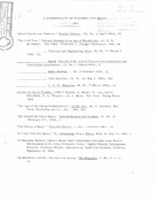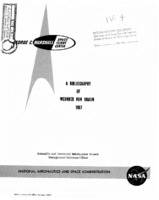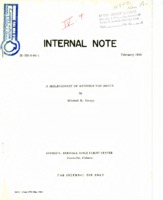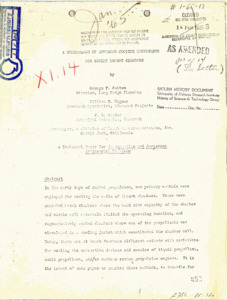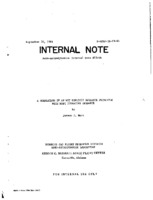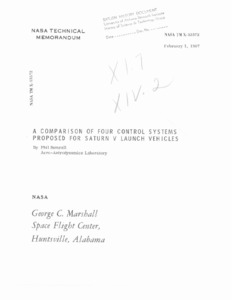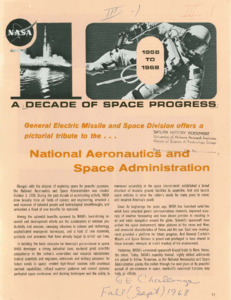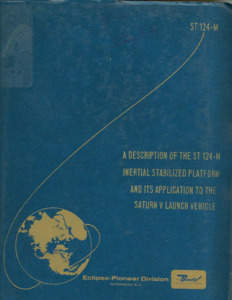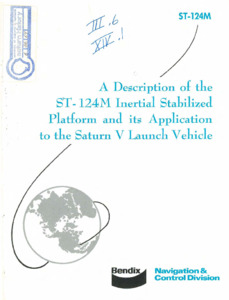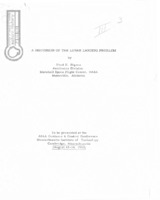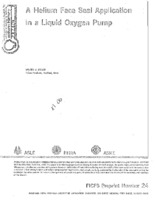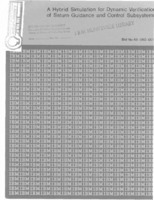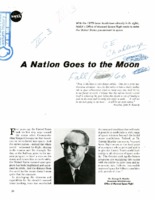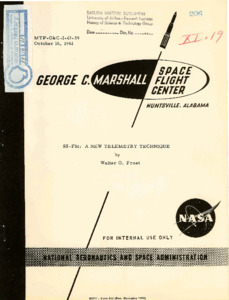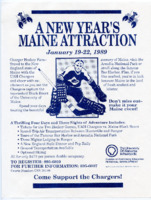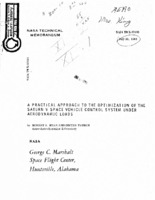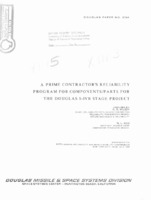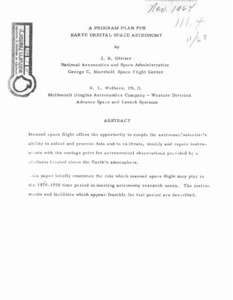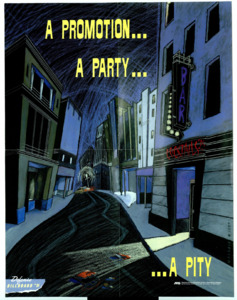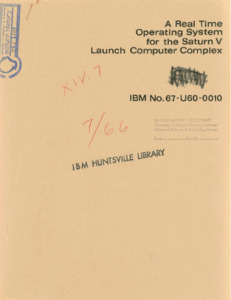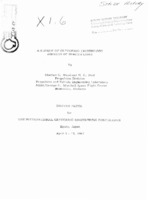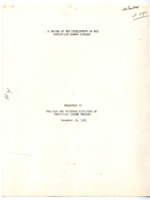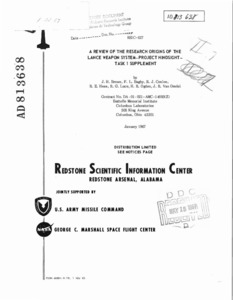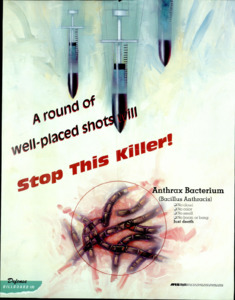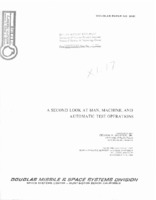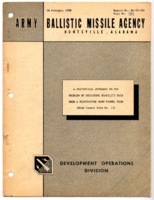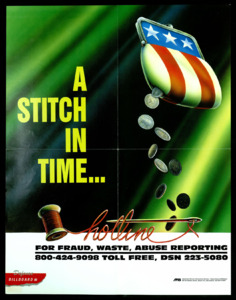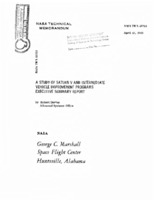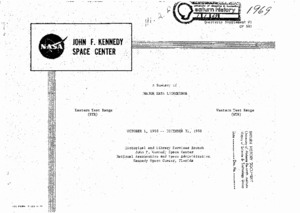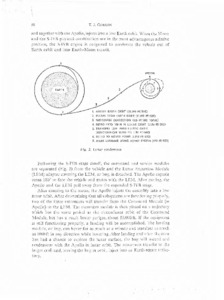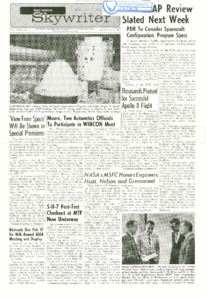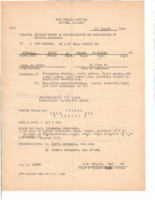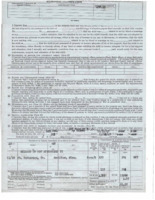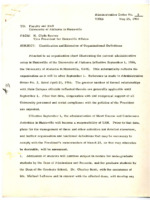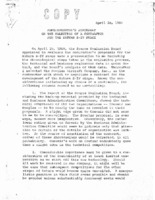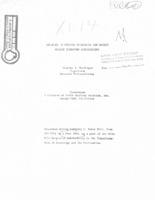
Browse Items (6320 total)
Sort by:
-
"A Bibliography of Wernher von Braun, 1967."
This official bibliography includes English- and foreign-language books, articles, and interviews. -
"A Bibliography of Wernher von Braun."
The document is designated for internal use only. -
"A Comparison of Advanced Cooling Techniques for Rocket Thrust Chambers".
The document is a technical paper for Astronautics and Aerospace Engineering Magazine.The copy has handwritten notes that appear to be for revisions. The abstract states "In the early days of rocket propulsion, two primary methods were employed for cooling the walls of thrust chambers. These were uncooled metal chambers where the heat sink capacity of the chamber and nozzle wall materials limited the operating duration, and regeneratively cooled chambers where one of the propellants was circulated in a cooling jacket which constituted the chamber wall. Today, there are at least fourteen different methods with variations for cooling the combustion devices and nozzles of liquid propellant, solid propellant, and/or nuclear rocket propulsion engines. It is the intent of this paper to examine these methods, to describe for each the useful range of operating conditions, as well as present and likely future applications, to define their limitations and associated problems. Emphasis is primarily placed on liquid rocket engines." -
"A Comparison of an MIT Explicit Guidance Principle with MSFC Iterative Guidance."
From the summary: "Both [guidance] schemes steer toward a specified end point. The MIT scheme uses thrust to cancel out the effective gravity, a nonlinear term, which may be inefficient in certain cases. The MSFC scheme is more closely connected with calculus of variations and optimization theory in a reasonable degree of approximation." -
"A comparison of four control systems proposed for Saturn V launch vehicles."
Presented are the results of a study comparing four proposed control systems for the first stage flight of Saturn V launch vehicles. The primary basis of comparison is the effect on structural loads, using the bending moments at three stations as load indicators. Two of the systems sense only the vehicle attitude and attitude rate, while the other two systems also sense the lateral acceleration. A yaw plane wind response analysis, including rigid body translation, rigid body rotation, four bending modes, five slosh modes, and a non ideal control system, was performed. The winds used in the study were the Marshall synthetic profile and three selected Jimsphere-measured real wind profiles. Load relief obtained from the addition of accelerometer feedback in the control loop amounted to about 10 percent at maximum bending moment station. In view of predicted structural capabilities of the vehicle, this reduction in loads was not considered sufficient to offset the added complexity and the slight reduction in rigid body stability . -
"A decade of space progress, 1958 to 1968: General Electric Missile and Space Division offers a pictorial tribute to the National Aeronautics and Space Administration."
Excerpt from G.E. Challenge, Fall (Sept.) 1968, pages 13 to 25. -
"A Description of the ST 124-M Inertial Stabilized Platform and its Application to the Saturn V Launch Vehicle."
This report is a description of the ST124-M inertial stabilized platform system and its application to the Saturn V launch vehicle. It is a summary report providing the system concept and not a theoretical presentation. Mathematical equations were included only where necessary to describe the equipment; however, the detail derivations supporting these equations were not presented since this was not the theme of the paper. -
"A description of the ST-124M inertial stabilized platform and its application to the Saturn V launch vehicle."
This report is a description of the ST-124M inertial stabilized platform system and its application to the Saturn V launch vehicle. It is a summary report providing the system concept, and not a theoretical presentation. Mathematical equations were included only where necessary to describe the equipment; however, the detailed derivations supporting these equations were not presented since this was not the theme of the paper. -
"A Discussion of the Lunar Landing Problem."
Digesu worked in the Astrionics Division of MSFC. This paper was presented at the AIAA Guidance & Control Conference, Massachusetts Institute of Technology, Cambridge, Massachusetts, August 12-14, 1963. -
"A DWI Conviction Can Bring a Social Life to a Screeching Halt...But It's a Great Way to Save Lives"
Bike parked in parking lot with man visible through window -
"A Helium Face Seal Application In a Liquid Oxygen Pump."
Presented at the Fourth International Conference on Fluid Sealing held in conjunction with the 24th annual meeting in Philadelphia, May 5-9, 1969. -
"A Hybrid Simulation for Dynamic Verification of Saturn Guidance and Control Subsystems."
This paper presents a discussion of a hybrid simulation used to dynamically verify the Saturn Guidance and Control subsystems. First, the Saturn vehicle is briefly described to provide background information. The Instrument Unit (IU) is considered in more detail to give a proper setting for the Guidance and Flight Control (G and FC) discussion that follows. After a brief description of the actual G and FC System operation, simulation models of the G and FC components are considered in detail. This is followed by a discussion of the model assignment to a particular computer (digital or analog) and justification for making that assignment. Finally, results of the AS-204/LM1 hybrid simulation studies are briefly considered with mention of the actual flight data. -
"A Nation Goes to the Moon."
Written by NASA Office of Manned Space Flight Associate Administrator George E. Mueller, this is an article from G. E. Challenge, Fall 1966, page 26 to 32. -
"A new telemetry technique."
A technique new to telemetry is discussed which promises to alleviate an enigma facing the telemetry engineer : How to adequately transmit the avalanche of vibration and other wideband data desired in the development phase of large missiles and launch vehicles. The data channels are stacked in the frequency spectrum as single sideband subcarriers which frequency modulate the RF carrier. The system design utilizes to advantage the statistical properties of vibration data to achieve maximum data transmission efficiency from the available RF carrier deviation. However, in contrast to proposed statistical predigestion techniques, the data is transmitted in raw form. -
"A New Year's Maine Attraction."
This flier advertises a trip to Maine for UAH hockey fans to see "the Chargers capture the top-ranked Black Bears of the University of Maine." Tours of Maine scenery and sites, a "New England Style Dinner," lodging, and transportation are offered in the package. -
"A Practical Approach to the Optimization of the Saturn V Space Vehicle Control System Under Aerodynamic Loads."
This paper includes the equations for the bending moment of a launch vehicle with the effects of bending and sloshing dynamics. It also includes a comparison between the bending moment response envelope of the measure winds and the bending moment response of the MSFC synthetic wind profile. -
"A Prime Contractor's Reliability Program for Components/Parts for the Douglas S-IVB Stage Project."
This paper, presented at the fifth annual Reliability and Maintainability Conference in New York City, contains a "prime contractor's reliability program for components/parts for the Douglas S-IVB stage project." These parts include special flight critical items and their complementary reliability engineering program plan is outlined in this paper. -
"A Program plan for earth orbital space astronomy."
Manned space flight offers the opportunity to couple the astronaut/scientist's ability to select and process data and to calibrate, modify and repair instruments with the vantage point for astronomical observations provided by a platform located above the Earth's atmosphere. This paper briefly examines the role which manned space flight may play in the 1970-1990 time period in meeting astronomy research needs. The instruments and facilities which appear feasible for that period are described.; Paper presented by J. R. Olivier, National Aeronautics and Space Administration, George C. Marshall Space Flight Center and H. L. Wolbers, Ph.D, McDonnell Douglas Astronautics Company - Western Division, Advance Space and Launch Systems. -
"A Promotion...A Party...A Pity"
Woman's purse and shoe on street outside of a bar as a cab drives away -
"A real time operating system for the Saturn V launch computer system."
Presentation aimed to encourage a final check on the Saturn V project before its first launch to ensure safety and success. -
"A Review of Cryogenic Technology Aspects of Space Flight."
This paper was presented at the International Cryogenic Engineering Conference in Kyoto, Japan. It details the use of cryogenic technology in rocketry and how its usage created "many new techniques and deeply stimulated many fields of cryogenic technology." -
"A Review of the Development of the Huntsville Campus Library."
Prepared by Librarian Christel L. McCanless and presented to the Arts and Sciences Committee on Huntsville Degree Program. The document includes a review of library materials and an outline of future plans, including comparisons to collections at other universities. -
"A review of the research origins of the LANCE weapon system -- Project hindsight -- Task 1 supplement."
This report includes a discussion of 57 research and exploratory development events that have been identified as contributing significantly to LANCE. Forty-six of these are research events. Eight of the research events deal with LANCE aerodynamics, four with propulsion, 24 with solid-state components used in the guidance and control system,and 10 with the research origins of the materials and manufacturing processes used in LANCE. In addition, 11 exploratory development events are identified. The principal concern of this study has been the identification of further research origins of LANCE and the 46 documented events are its major product. A further concern and obligation of this study has been to provide HINDSIGHT with some additional data on the research phenomenon including some further observations on the nature and route of research utilization.; FOREWORD: The purpose of this report is to present a survey of fundamental research contributing to the successful development of the LANCE weapon system. Included in this report are discussions of research inputs to a number of LANCE systems and technology areas. The circumstances of these research contributions to LANCE are discussed. The implications of these examples of research utilization are analyzed and some general observations and conclusions on the research payoff phenomena are given. This report was requested by the Army Missile Command as a supplemental contribution to Project HINDSIGHT.; Contract No. DA-01-021-AMC-14693(Z).; Battle Memorial Institute ,Columbus Laboratories.; RSIC-627.; Includes letter from W. Metscher, Lt. Col. to Mr. David L. Christensen dated March 14, 1969. -
"A round of well-placed shots will stop this killer!; Anthrax Bacterium "
Shots and picture of anthrax bacterium under a microscope -
"A Second Look at Man, Machine, and Automatic Test Operations."
A summary found following the errata page reads: "This paper presents a second look at the subject of the man-machine relationship in automatic test operations. 'Man, Machine, and Automatic Test Operations' was presented by the writer at Battelle Memorial Institute in November of 1963...It is the purpose of this second look at the man-machine interface to pinpoint those concepts which have proven their worth with time and those concepts which have proven to be weak, and as a result modified with time." This paper was prepared by George F. Meister, Jr. -
"A Stitch in Time...hotline for fraud, waste, abuse reporting"
coin purse with a hole in it dropping coins and needle and thread -
"A Study of Saturn V and Intermediate Vehicle Improvement Programs Executive Summary Report."
The abstract notes, "The purpose of this report is to summarize the results of three companion studies designed to investigate both the performance growth potential of the Saturn V and the utilization of Saturn V equipment to fill the performance gap in the intermediate payload range between the Saturn IB and the Saturn V. This report includes significant data which is intended to aid the planning of future missions. This data reflects some of the various vehicle configurations which can be used by mission planners to satisfy payload desires in excess of the Saturn IB and Saturn V." -
"A summary of major NASA launchings" between October 1st and December 31st, 1968.
This is the first Quarterly Supplement to the October 1968 edition of GP 381, ''A Summary of Major NASA Launchings (Eastern Test Range and Western Test Range)." This Supplement covers the period from October 1 to December 31, 1968. Two additional Quarterly Supplements will be issued during 1969. Each of these will list those major NASA launchings occurring during the three-month period it covers. The basic publication will be revised and reissued, incorporating the information contained in the Supplements, as well as covering the final three-month period, subsequent to October 1, 1969. William A. Lockyer, Jr. -
"A survey of propulsion problems as related to space vehicle design."
Incomplete document. Displays errors in space-vehicle design as they relate to space travel. -
"AAP review slated next week."
News article detailing the purpose of the PDR, that being to review the APP's configuration and program plans and technical specifications. -
"Abfahrt nach Niagara Falls, thru Hv into Tennessee! Return to Huntsville, Ala - Monte Sano."
Film shows Konrad, Klaus, and Ingeborg Dannenberg returning to their home in Monte Sano outside of Huntsville, Alabama. Also shows family departing for Niagara Falls. Konrad Dannenberg's additional notes on the film box read, "Begin w/ 2nd Half! when [illegible]!" Summer 1956. -
"Abfahrt von Huntsville - Washington Landung in New York / N.Y. AIRPORT."
The film's first part shows Konrad Dannenberg boarding a flight at the Huntsville airport. The film picks back up above Washington D.C. where Konrad captures pictures of the Pentagon from above and shots of the Washington D.C. airport once landed. -
"Abfahrt Woodland Hills - Monterey - Carmel on the Sea - bird rock - seal rock."
Klaus, Konrad, and Ingeborg drive up to near Monterey, California, summer 1956. They show portions of the drive up as well as all of them walking along the coastal cliffs. -
"Abstract Record of Hospitalization and Notification of Hospital Discharge" for Edwin D. Burwell Jr.
The document notes Edwin D. Burwell Jr.'s personal information, date of admission, diagnoses, operations, and recommendations for assignment. -
"Administrative Order No. 8."
Sent from H. Clyde Reeves, Vice President for Huntsville Affairs, to all faculty and staff, this order outlines the "current administrative setup in Huntsville of the University of Alabama." The document provides clarification of certain administrative roles, including those of Finance Officer Earl Jacoby, Assistant to the Vice President and Director of Community Relations Philip M. Mason, and Director of Instruction Charley Scott. The order also outlines the structure of academic departments, roles of department chairs, and the organization of the Research Institute. It includes an organizational chart of the university, and pencilled notes have been added by then-head librarian Christel L. McCanless. -
"Advances in Pumping Technology and Rocket Engine Turbopump Applications."
Presented by Charles A. MacGregor, Supervisor, Advanced Turbomachinery during Workshop D, Royce Hall, Room 160 at UCLA on 2 June 1964, as a part of the NASA-UCLA Symposium and Workshop on the Transformation of Knowledge and Its Utilization. The introduction notes, "This report is divided into two general parts. The first part is a description of turbopumps for liquid rocket engines as they exist today. For completeness and understanding, some background information is included on why turbopumps have evolved to their present configurations. The second part suggest portions of this effort that may have some applicability to the general economy."
